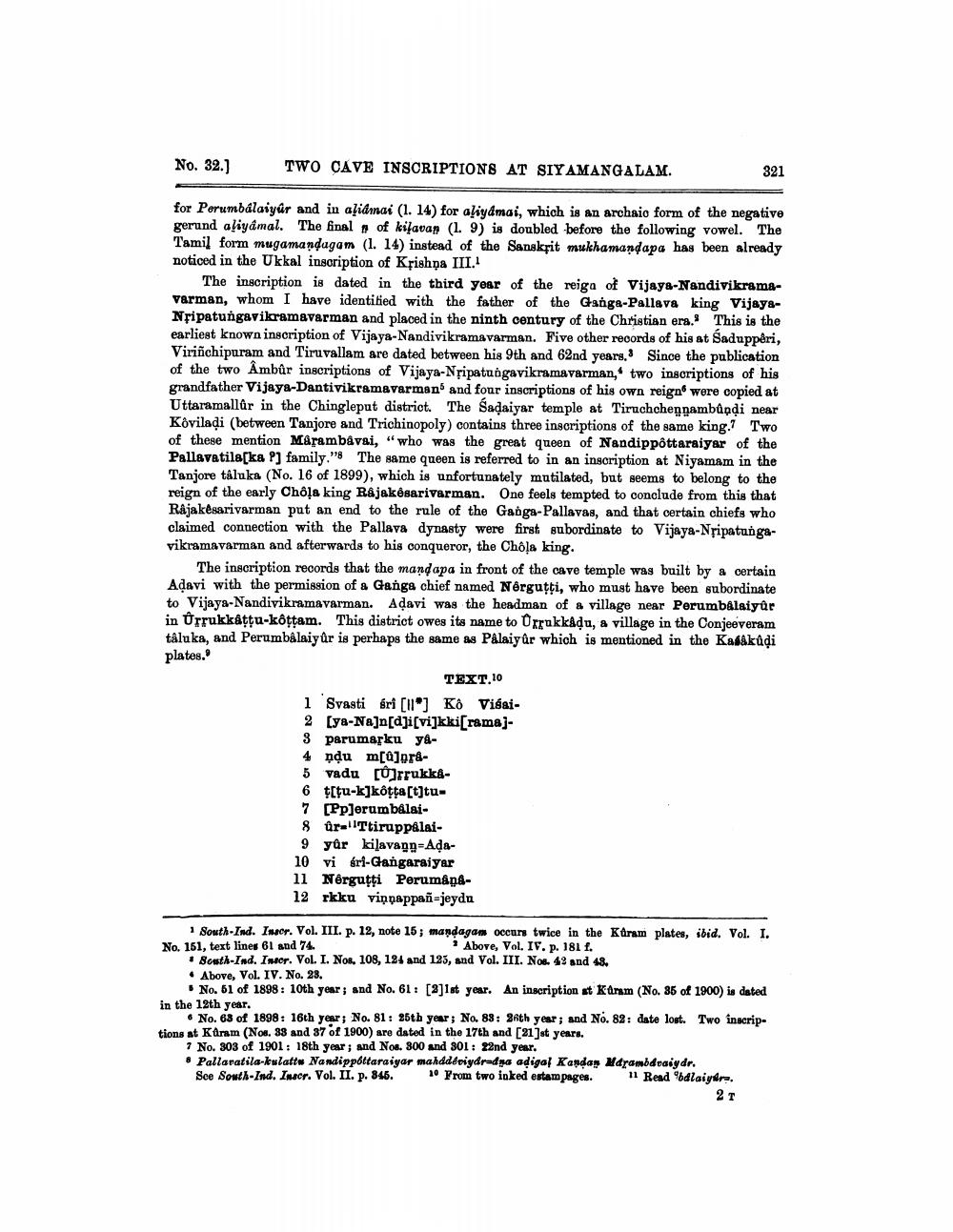________________
No. 32.)
TWO CAVE INSCRIPTIONS AT SIYAMANGALAM.
321
for Porumbálaiyar and in alidai (1. 14) for aliyamai, which is an archaio form of the negative gerund aliy&mal. The final of kifavar (1.9) is doubled before the following vowel. The Tamil form mugamandagam (1. 14) instead of the Sanskrit mukhamandapa has been already noticed in the Ukkal inscription of Krishna III.
The inscription is dated in the third year of the reiga of Vijaya-NandivikramaVarman, whom I have identified with the father of the Ganga-Palleva king VijayaNripatungavikramavarman and placed in the ninth century of the Christian era. This is the earliest known inscription of Vijaya-Nandivikramavarman. Five other records of his at Sadupperi, Viriñchipuram and Tiruvallam are dated between his 9th and 62nd years. Since the publication of the two Âmbûr inscriptions of Vijaya-Nripatungavikramavarman, two inscriptions of his grandfather Vijaya-Dantivikramavarman and four inscriptions of his own reiga were copied at Uttaramallar in the Chinglepat district. The Sadaiyar temple at Tiruchchengambûndi near Koviladi (between Tanjore and Trichinopoly) contains three inscriptions of the same king. Two of these mention Marambâvai, "who was the great queen of Nandippottaraiyar of the Pallavatila[ka P) family." The same queen is referred to in an inscription at Niyamam in the Tanjore tâluka (No. 16 of 1899), which is unfortunately mutilated, but seems to belong to the reign of the early Chôļa king Rajakesarivarman. One feels tempted to conclude from this that Rajakesarivarman put an end to the rule of the Ganga-Pallavas, and that certain chiefs who claimed connection with the Pallava dynasty were first subordinate to Vijaya-Nripatungavikramavarman and afterwards to his conqueror, the Chola king.
The inscription records that the mand apa in front of the cave temple was built by a certain Adavi with the permission of a Ganga chief named Nêrgutti, who must have been subordinate to Vijaya-Nandivikramavarman. Adavi was the headman of a village near Perumbalaiyûr in Orrukkattu-kottam. This district owes its name to Orrukkadu, a village in the Conjeeveram tåluka, and Perumbalaiyûr is perhaps the same as Palaiyûr which is mentioned in the Kafákůại plates.
TEXT.20 i Svasti sri [ll] Kô Visai2 [ya-Na]n[dji[vi]kki[ramaj3 parumasku yl4 ndu m[@]ord5 vadu [U]Frukki6 [tu-k]kôţta[t]tu7 [Ppjerumbalai8 ûrallTtiruppalai
9 yûr bilavapp-Ada10 vi sri-Gangaraiyar 11 Nêrgutti Peruman12 rkku viņpappañ-jeydu
1 South-Ind. Inser. Vol. III. p. 12, note 15; mandagam occurs twice in the Kdram plates, ibid. Vol. I. No. 161, text lines 61 and 74.
Above, Vol. IV. p. 181 f. • Scath-Ind. Incor. Vol. I. Nos, 108, 124 and 125, and Vol. III. Nos. 49 and 48. . Above, Vol. IV. No. 23.
* No. 51 of 1898: 10th year; and No. 61: [2]1st year. An inscription st Kangm (No. 85 of 1900) is dsted in the 12th year.
No. 68 of 1898: 16th year; No. 81: 35th year; No. 88: Bath year; and No. 82: date lost. Two inscriptions at Karam (Nou. 88 and 37 of 1900) are dated in the 17th and [21]st years.
7 No. 303 of 1901: 18th year; and Nos. 800 and 301 : 22nd year. . Pallaratila.kulattu Nandippóttaraiyar mahdddviydradyo adigal Kandar Mdramidraig dr. Sce South-Ind. Inscr. Vol. II. p. 846. 10 From two inked estampages. 11 Read dlaiyir.
2 T




